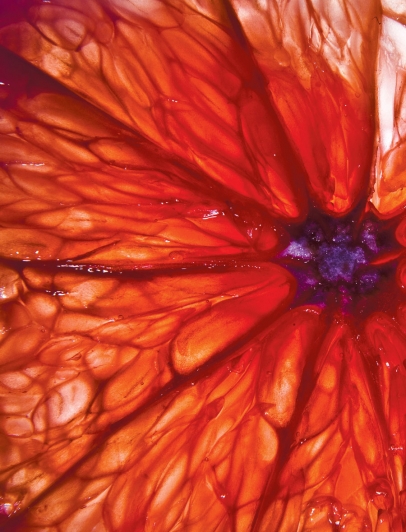Blood Oranges
My first taste of blood oranges was in a vineyard in southern France. I was helping with the harvest and my 3-year-old daughter, Ethel, was keeping me company while I worked alongside a crew of recently immigrated Algerians. When we broke for a snack, one of the men offered Ethel and me some of his orange. It was orange and ruby red on the outside and streaked red inside, and it tasted like raspberries.
Although I had grown up in Southern California surrounded by orange groves—my father’s first business was a fresh orange juice stand at the Main Beach parking lot in Laguna Beach—an orange that was red inside was completely new to me.
After that initial encounter, I began to see boxes of blood oranges displayed in front of the small epiceries, or grocery stores, in the villages around my house in Provence. Usually a few of the oranges would be wrapped in decorative, brightly colored tissue paper printed in Spanish or Italian, depending upon their origin. That winter, my winter living in Provence, I bought blood oranges as a treat whenever I could.
When we moved back to California I was unable to find them in local markets and it was not until one winter in Italy that I rediscovered the jewel-like, exotic oranges. There, vendors sold blood orange juice by the glassful, hotels had it on tap and, once again, I saw boxes of them for sale, some wrapped in tissue.
I returned to California this time determined to find a nursery propagating blood oranges, and to plant them on my small farm in Northern California. We did just that, planting both the Moro and Tarocco varieties. That was 25 years ago. Sadly, the trees were damaged by fire this summer, so we will be taking the trees out this winter, and will replant.
Historically, most commercial groves of blood orange trees have been in Spain and Italy. Over the past 30 or so years, though, blood oranges have begun to be grown commercially in California, but not as yet on the scale that they are grown in the Mediterranean.
There are a number of varieties, but the main ones are Moro, Tarocco and Sanguinelli, also known as Sanguinello. The red coloring in all blood oranges comes from naturally occurring anthocyanin, the same compound that gives other fruits and vegetables, like pomegranates and apples, their coloring.
Moros have a deep, dark maroon pulp and the skin is often very, very deep, dark red. They are a bit seedier than the Taroccos, but they make excellent juice, which is their primary use in Italy and what I use them for as well. The Taroccos, which are the most popular Italian table orange, have very few seeds, and the flesh can vary from dark maroon to streaky maroon and orange, and the skin is variable as well. The Red Orange of Sicily has been awarded the Protected Designation of Origin (DOP) by the European Union.
In Spain, the primary blood orange is the Sanguinelli, which is sometimes only orange on the outside, with lighter interior pigmentation than either the Moro or the Tarocco. It is quite sweet.
Regardless of variety, all blood oranges can be juiced, eaten out of hand, used in salads and baking—in short, in any way that you would use a navel or Valencia orange. The dried rinds are used in Italian biscotti, for example, and the juice and rinds are used to flavor creams for pastries. In Spain, one of the best breakfasts is grilled bread, slightly charred, then rubbed with garlic, and topped with slices of blood orange and Serrano ham.
Blood orange juice can be mixed with sparkling water for a refreshing homemade soda, similar to the ones you find from Italy in cans, or the juice can be mixed with sparkling wine to make a pinkish-red Mimosa.
A popular salad in both Italy and North Africa is a platter of sliced oranges, sprinkled with red onion and olives and dressed with extra-virgin olive oil. There are lots of variations on this theme, and my personal favorites include the addition of anchovy fillets.
No matter how you choose to use blood oranges, whether simply for juice, in a salad, or baking them in my tart recipe here, remember they are strictly a seasonal fruit. The local season begins in late November and continues on through February.





